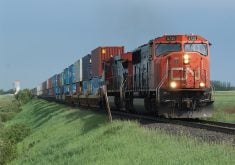Frigid winter temperatures on the Prairies combined with rain-related loading delays on the West Coast are contributing to growing vessel lineups at Canada’s busiest marine port.
As of early February, the number of ships waiting to be loaded with grain at the Port of Vancouver was around 30, according to Canada’s Grain Monitoring Program (GMP).
That’s well above the port’s one-year average of 22 vessels and the highest number in almost a year.
Mark Hemmes, president of Quroum Corp., the Edmonton company that’s contracted to manage the GMP, said those numbers are concerning, but they aren’t indicative of a crisis in the Canadian grain handling and transportation system — at least not yet.
Read Also

Farming Smarter receives financial boost from Alberta government for potato research
Farming Smarter near Lethbridge got a boost to its research equipment, thanks to the Alberta government’s increase in funding for research associations.
“If people are concerned, they probably should be,” said Hemmes. “But I wouldn’t be ringing any alarm bells just yet.”
In a recent interview, Hemmes said frequent rain in late January hampered ship loading.
Conditions have improved since, but it will take some time before vessel lineups return to more normal levels.
Frigid winter temperatures across the Prairies also affected train movements at Canadian Pacific Railway and Canadian National Railway in late January and early February.
According to the Ag Transport Coalition, CN’s car order fulfillment rate declined for four consecutive weeks in January.
In Week 27 of the 2017-18 crop year, the seven-day period that ended Feb. 3, CN supplied just 54 percent of the grain hopper cars that were ordered, ATC said in its weekly rail performance report distributed Feb. 11.
Through the first 27 weeks of the current shipping year, CN has rationed more than 13,000 hopper car orders placed by ATC shippers, the report said.
That’s more than five times as many as last year at the same time.
CN’s on-time car order fulfillment rate has fallen below 60 percent in seven of 27 weeks, with car rationing affecting 11 percent of all hopper car orders placed at CN, the ATC report said.
Meanwhile, CP’s car order fulfilment fell to 78 percent in Week 26 and 69 percent in Week 27.
Those were CP’s worst weeks so far in terms of 2017-18 shipping season performance.
Wade Sobkowich, executive director of the Western Grain Elevators Association, said larger-than-normal vessel lineups at the West Coast are already resulting in demurrage costs and could trigger additional contract extension penalties if grain exporters are unable to execute sales within specified time frames.
“Time will tell what the financial impact will be,” Sobkowich said.
“What I can tell you is that (WGEA members) are incurring vessel demurrage charges right now.
“They’re not what we would consider to be major charges at this point but the longer this goes, the more vessel demurrage we’re going to pay as a grain industry and that translates into less value that we’re able to return (to farmers).”
As of Jan. 27, Vancouver had nine ships at berth, 15 more at anchor in the Burrard Inlet or English Bay, and six others waiting along the southern shore of Vancouver Island.
Individual shipping contracts specify how much time is allotted for loading a vessel, but the window is typically about 12 days, sometimes up to 18, said Sobkowich.
Demurrage costs are in the range of $10,000 per day for a Panamax-sized vessel.
Lack of fluidity in the grain-handling system, particularly on CN’s network, is also complicating grain origination efforts at some country elevators, Sobkowich said.
Delivery schedules are being adjusted at many locations to account for lack of shipping capacity and loading delays at port.
Throughout January, grain inventories in the country elevator system showed a gradual increase, rising from 77 percent of working capacity early in the month to 84 percent of working capacity as of Jan. 27.
Some delivery points on the CN network are no longer taking deliveries until grain inventories can be drawn down.
Sobowich described CN’s car order fulfilment record since August 2017 as “very poor.”
“We’re having to adjust a lot of pieces in the logistics system to account for the lack of capacity that we’re getting on CN,” he said.
“Yes, cold weather is a factor but it isn’t the largest factor. The largest factor is that CN doesn’t have enough capacity for the grain industry due to the increase in demand from frack sand and intermodal, primarily.”
By comparison, CP, which is subject to the same weather conditions as CN, has been servicing the grain industry well, he added.
Hemmes said grain inventory levels at country elevators and export terminals could be drawn down quickly if weather conditions improve.
“Right now, there’s just not enough grain in position to load the vessels. Some of that has to do with rail service and a little bit has to do with bad weather at port as well.”


















